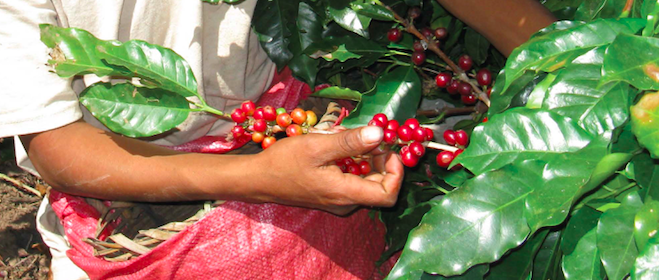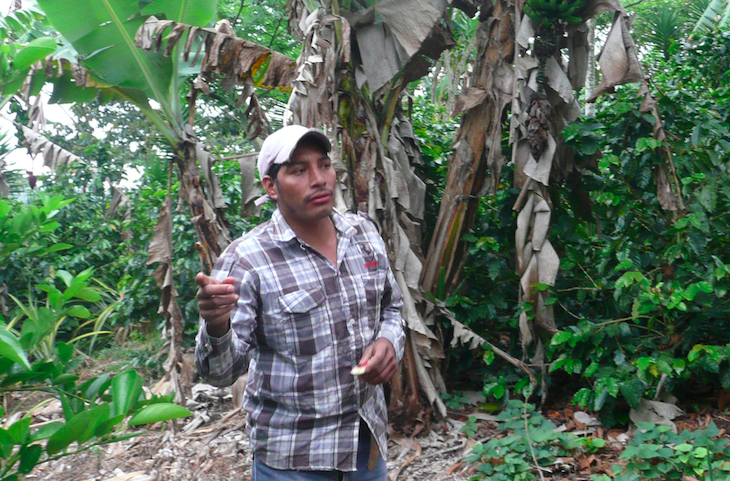Brewed Awakening

It’s time we opened our eyes to economic and social dimensions of coffee ● by Catherine M. Tucker
Do you drink coffee? If so, you are among the 80% or more of adult Americans who drink coffee at least occasionally. Coffee is an ubiquitous part of daily life in the USA, yet few of us have time to think about how coffee is produced, its social and environmental ramifications, or the experiences of growers who depend on coffee as their main source of income. This is true even though opportunities for awareness are greater today than ever before. If we look closely at coffee in the grocery store, we are likely to see packages declaring “organic,” “shadegrown,” “Fair Trade,” or “bird friendly” on the labels. Each of these labels represents a claim to quality that encompasses environmental, economic and social dimensions, and usually carries a heftier price than other brands on the shelf. Should we care about these labels on the package? Do they represent better quality, and do they make a difference for farmers on the ground? After 20 years of studying and working with coffee farmers in Central America, my answer is “Yes.” Your choices do make a difference to coffee farmers.
If You Want Good Coffee, Farmers Need to Make a Living
Coffee production provides a livelihood for an estimated 25 million growers and farm workers around the world. The vast majority of coffee growers are smallholders who own less than ten acres of land, while farm workers are often landless. Many struggle to keep food on the table. They depend on good coffee prices and a successful harvest to make a living, but over the past two decades, their income from coffee has been slipping. In the 1980s, most coffee farmers gained about ten cents of the price of a cup of coffee sold. Today, it´s around two cents. At the same time, producer’s costs are rising.
Pedro Diaz and his wife, Maria, own a four-acre farm in central Honduras that includes a coffee plantation shaded by fruit trees, a maize and bean field. They live with their three school age children. in a two-room adobe house with an outhouse. The whole family works on the farm to produce their coffee, maize and beans. They have seen fertilizer prices double in the last five years, and they have had to buy less, which lowers their coffee and maize harvests. They used to grow enough corn for tortillas (their staple food) to last most of the year, now they need to buy more at the market with ever higher prices. Coffee provides their main source of income, but prices fluctuate from year to year. In a good year, they have enough to eat, buy clothing, and send the children to school. When coffee prices fall – which happens frequently — Pedro migrates to find temporary work, and Maria and the children find it hard to care for their coffee and crops alone. Coffee plants need consistent care throughout the year to produce high quality coffee – trimming, pruning, removing diseased plants, and applying organic or chemical fertilizers. Above all, coffee must be picked when the cherries are perfectly ripe and transported rapidly to a processing center, or else the cherries will ferment and buyers will cut their prices. To pick coffee on time, they need to hire extra labor, but coffee pickers want ever higher wages; they can get easier work in cities. As a result, Pedro often receives low prices because he and his family find it difficult to maintain their plantations and pick coffee at the right time. Maria says that her greatest worry is that someone in the family will fall ill, because they cannot afford medical care. Pedro dreams of finding a better option than growing coffee. The irony is that Pedro and Maria’s land is perfectly suited to produce high quality coffee, if only they had the resources to manage it well. adequately. For Pedro and other growers, economic insecurities make it difficult to invest the care needed to produce high quality coffee, and may eventually compel them to do something else.
Economic Pressures to Expand Production Are Associated with Environmental Destruction
Farmers face many pressures to expand production, which typically involves cutting down tropical mountain forests or shade trees to plant sungrown coffee. Unfortunately, sun-grown coffee requires toxic chemicals to control weeds and infestations, and is associated with soil degradation, water contamination, loss of wildlife habitat, and health problems for workers exposed to chemicals and polluted water from runoff. Smallholders like Pedro and Maria prefer to raise shade-grown coffee, because shade trees can provide fruit, support soil fertility, discourage weeds, and shelter birds, wildlife, and beneficial insects that control pests. The downside is that shade-grown plantations tend to produce less than sun-grown plantations. While the flavor of shade coffee is richer, it takes longer to ripen, and farm-gate prices fall over the course of the harvest. Thus many farmers have replaced shade with sun-grown coffee and cut forests to increase their plantations, even if they realize the risks of environmental destruction.
Alternative Trade Aims to Mitigate Economic and Environmental Problems
Organic, Fair Trade, shade-grown and other certifications represent organized efforts to counteract economic and environmental problems of global market inequities by paying better prices to producers. Many certifications set standards and offer technical guidance to improve environmental practices and the quality of coffee produced. Together, these efforts are known as “Alternative Trade.” Smallholder farmers and cooperatives that obtain Fair Trade certification and find a buyer will be paid above market prices. Environmental organizations offer certifications for organic, shade-grown, and bird friendly coffee as a way to encourage sustainable methods and give farmers a price premium for the extra work this requires. For smallholder farmers who retain shade trees in their plantations, these certifications can support their decision to raise environmentally friendly, high quality coffee.
Better Prices Can Make a Real Difference for Coffee Farming Families
Around the world, farmers have been eager to obtain certification in order to get better prices for their coffee. Enos Sanchez helped to found COCATECAL, a Honduran cooperative. He worked with 32 other coffee farmers to gain Fair Trade and Rainforest Alliance certification, which requires a variety of shade trees and prohibits toxic chemicals, among other requirements. Enos discovered that the certification carries unexpected challenges and costs. He needed to improve housing to meet mandated standards, invest time and resources to make organic fertilizers, and travel to cities to seek buyers for the cooperative’s coffee. Recently, COCATECAL won first place in a coffee-tasting competition organized by Slow Food Italy, but buyers did not keep their promise to pay an especially high price. Even so, Enos and other COCATECAL farmers have been receiving higher prices for their coffee than their neighbors who are not in the cooperative. Enos has been able to buy more land, send his children to school, and his wife has started a small store. José Elías Perez, COCATECAL’s former president, told me that even when they don’t get the prices they want, their careful practices assure the future productivity of the land. Although certifications do not guarantee better prices, studies indicate that alternative trade can help farmers earn more, especially when market prices are low.
Enos Sanchez
●
Growth of Consumer Demand Is Necessary for Alternative Trade to Succeed
With the growth of certification, the supply now exceeds the demand for certified, high quality coffee. When certified cooperatives like COCATECAL cannot find a buyer, their coffee ends up being sold at normal prices to conventional markets. If the goals of alternative trade are to be reached, more consumers need to be willing to spend a bit more for their coffee, and this is a tough argument to make for many Americans who barely make ends meet. The challenge is exacerbated by the bewildering diversity of certifications and labels. How can a consumer learn what labels represent best practices, and work well to improve farmers conditions?
Become An Informed Consumer
The internet, libraries, and fair trade cooperatives offer extensive information regarding different types of certification and labels. National purveyors of 100% Fair Trade and sustainably sourced coffee include Equal Exchange, Rainforest Alliance, and Smithsonian Bird Friendly coffee. Local cooperatives such as Bloomingfoods can often provide detailed statements about how they source their coffee and other goods. If you join a fair trade cooperative, you may also have the opportunity to vote on the criteria for selecting food sources. Many local and regional coffee roasters are committed to buying organic and fairly traded coffee, and will be happy to explain their business practices. Today, many independent roasters and coffee shops are buying their coffee through direct trade arrangements, in which they or trusted business partners travel to buy their coffee personally from growers, and growers can negotiate a fair price. As a consumer, a small investment of time and effort can help you to make informed decisions about which kind of coffee makes the most sense for your values and your budget.

